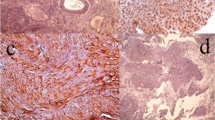Abstract
Objectives
This study was carried out as a prospective pilot study to evaluate the potential of survivin mRNA measurement in patients suspicious for urothelial bladder cancer (BC). Data were also analyzed for possible influences of secondary urological findings on survivin measurements.
Methods
Survivin was measured by an mRNA assay in voided urine samples of 50 patients with suspicion of new or recurrent BC prior to transurethral resection. Sample evaluation was possible in 49 cases. Histopathology revealed no malignancy in 17 (35%) and BC in 32 (65%) patients. Survivin mRNA was quantitated by real-time PCR from frozen cell pellets of centrifuged urine samples. A ROC analysis of the survivin data was performed.
Results
ROC analysis identified the best cut-off level at 10,000 mRNA copies, resulting in a sensitivity of 53% and a specificity of 88%. Seven of the 20 pTa tumors (35%), all four pT1 (100%) and all four muscle-invasive tumors (100%) were detected. Of four patients with carcinoma in situ (Cis), 50% could be identified. Only two patients (4%) were assessed as false positive. Histologically confirmed cystitis and concomitant urological findings (inflammatory cells in urine, microhematuria and others) had no detectable influence on survivin measurements.
Conclusion
In present group of patients, survivin was a reliable biomarker for high-grade urothelial BC (sensitivity 83%), but not for low grade (sensitivity 35%) urothelial BC with a high specificity (88%). No confounders influencing the results of survivin measurements could be identified.

Similar content being viewed by others
References
Barocas DA, Clark PE (2008) Bladder cancer. Curr Opin Oncol 20:307–314
Noyes K, Singer EA, Messing EM (2008) Healthcare economics of bladder cancer: cost-enhancing and cost-reducing factors. Curr Opin Urol 18:533–539
Stenzl A, Hennenlotter J, Schilling D (2008) Can we still afford bladder cancer? Curr Opin Urol 18:488–492
Vrooman OP, Witjes JA (2008) Urinary markers in bladder cancer. Eur Urol 53:909–916
Lokeshwar VB, Selzer MG (2006) Urinary bladder tumor markers. Urol Oncol 24:528–537
Herman MP, Svatek RS, Lotan Y, Karakiewizc PI, Shariat SF (2008) Urine-based biomarkers for the early detection and surveillance of non-muscle invasive bladder cancer. Minerva Urol Nefrol 60:217–235
Altieri DC (2004) Molecular circuits of apoptosis regulation and cell division control: the survivin paradigm. J Cell Biochem 92:656–663
Caldas H, Jiang YY, Holloway MP et al (2005) Survivin splice variants regulate the balance between proliferation and cell death. Oncogene 24:1994–2007
Margulis V, Lotan Y, Shariat SF (2008) Survivin: a promising biomarker for detection and prognosis of bladder cancer. World J Urol 26:59–65
Smith SD, Wheeler MA, Plescia J, Colberg JW, Weiss RM, Altieri DC (2001) Urine detection of survivin and diagnosis of bladder cancer. JAMA 285:324–328
Shariat SF, Casella R, Khoddami SM et al (2004) Urine detection of survivin is a sensitive marker for the noninvasive diagnosis of bladder cancer. J Urol 171:626–630
Wang H, Xi X, Kong X, Huang G, Ge G (2004) The expression and significance of survivin mRNA in urinary bladder carcinomas. J Cancer Res Clin Oncol 130:487–490
Weikert S, Christoph F, Schrader M, Krause H, Miller K, Muller M (2005) Quantitative analysis of survivin mRNA expression in urine and tumor tissue of bladder cancer patients and its potential relevance for disease detection and prognosis. Int J Cancer 116:100–104
Kenney DM, Geschwindt RD, Kary MR, Linic JM, Sardesai NY, Li ZQ (2007) Detection of newly diagnosed bladder cancer, bladder cancer recurrence and bladder cancer in patients with hematuria using quantitative rt-PCR of urinary survivin. Tumour Biol 28:57–62
Sobin LH (ed) (2002) TNM classification of malignant tumours, vol 6. Wiley Liss, New York, pp 199–202
Hanley JA, McNeil BJ (1982) The meaning and use of the area under a receiver operating characteristic (ROC) curve. Radiology 143:29–36
Moussa O, Abol-Enein H, Bissada NK, Keane T, Ghoneim MA, Watson DK (2006) Evaluation of survivin reverse transcriptase-polymerase chain reaction for noninvasive detection of bladder cancer. J Urol 175:2312–2316
Shariat SF, Ashfaq R, Karakiewicz PI, Saeedi O, Sagalowsky AI, Lotan Y (2007) Survivin expression is associated with bladder cancer presence, stage, progression, and mortality. Cancer 109:1106–1113
Feil G, Horstmann M, Leng G et al (2008) Urine-based tumor marker tests are a helpful tool in early diagnosis of bladder cancer in high-risk populations—Interim data of the prospective study UroScreen. J Urol 179:325
Acknowledgments
We thank Fujirebio Diagnostics, Inc. (FDI; Malvern, PA) for supplying the survivin reagents and are grateful to Judith Delbanco and Ursula Kuehs for expert technical assistance.
Conflict of interest statement
There is no conflict of interest.
Author information
Authors and Affiliations
Corresponding author
Additional information
Marcus Horstmann and Heike Bontrup contributed equally to this work.
Rights and permissions
About this article
Cite this article
Horstmann, M., Bontrup, H., Hennenlotter, J. et al. Clinical experience with survivin as a biomarker for urothelial bladder cancer. World J Urol 28, 399–404 (2010). https://doi.org/10.1007/s00345-010-0538-2
Received:
Accepted:
Published:
Issue Date:
DOI: https://doi.org/10.1007/s00345-010-0538-2




